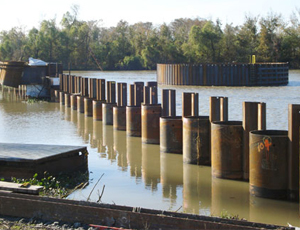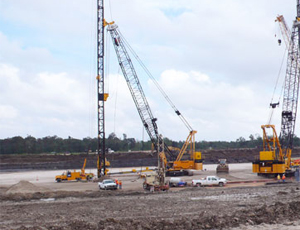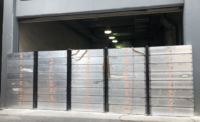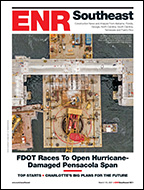After a design summit to cut costs, the U.S. Army Corps of Engineers and its contractors have headed off a possible $150-million to $300-million cost overrun on the $1-billion Gulf Intracoastal Waterway West Closure Complex in New Orleans. The closure complex consists of a strategic storm-surge barrier of walls, levees, gates and pumps to protect the southern flank of the city. It includes navigation gates and what will become the largest pump station in the U.S.


As designs neared completion this fall, the Corps realized costs were heading to exceed authorized funding. So, from Oct. 26 to 29, representatives from prime contractor Gulf Intracoastal Constructors—a joint venture of Kiewit Corp., Omaha, Neb., and Traylor Bros. Inc., Evansville, Ind.—as well as from engineering firms and consultants, met with representatives from several Corps districts in New Orleans to brainstorm cost-saving alternatives.
The session resulted in numerous design changes that trade off some “nice to haves” for necessities, says Tom Podany, chief of the Corps’ Protection and Restoration Office. “We had a goal of $150 million to $300 million in savings we thought would be realistic to achieve,” Podany says. “We got everyone together to hash out ideas, make sure we had all ideas fully vetted, and, ultimately, we had about 47 ideas that will result in design changes.”
The Corps touts the project as the New Orleans District’s first use of the Early Contractor Involvement delivery method and the summit as an example of it. Awarding GIC the $6.97-million base contract on Aug. 4 for preconstruction services and pile load tests expedited the process, Podany says.
By bringing in the contractors early for input on the designs and specs, changes can be implemented without having to go back after award and modify contracts, Podany says. “ECI allowed us to get ideas up front before designs were finalized. With ECI, you have an opportunity to adjust design and implement with the contractor,” he adds.
A fast-approaching June 2011 deadline is the driving force behind the Corps’ decision to use ECI, and that, as well as the high cost, led to the decision to call the design summit, Podany says. And it definitely helped curb cost on the project, he says. “If changes had not been made, we would have gone beyond that $856 million,” he says. “We have [to do] due diligence to provide the public with the best value, and ECI provided us the opportunity to work with contractors and stakeholders to work out ways to optimize designs, manage costs and maintain schedule,” he says.
However, some industry people involved in the summit say it was nothing more than value engineering, and, to truly be an example of ECI, it should have occurred earlier and before GIC was actually under contract.
GIC broke ground on Aug. 6. By Dec. 3, it had driven 250 of the 1,400, 30-in.-dia., 137-ft-long pump-station foundation support piles and 75 of the 116, 54-in.-dia., 140-ft-long king piles associated with the sheet pile for the combi-wall cofferdam. It also had excavated 300,000 cu yd of material for the pump station.
The largest cost saving developed during the summit, made at the suggestion of GIC, modifies the 20,000-cfs pump station to save $50 million to $100 million, according to Corps estimates. The savings come from lowering the discharge elevation of the pumps to raise each pump’s capacity to 1,880 cfs from 1,540 cfs. This move allows the number of pumps to be reduced to 11, from 13, and also helps cut the size of the building to house them.
The Corps’ original design called for placing the pumps at an elevation of plus-16 ft, which would surpass by 2 ft the predicted hydraulic elevation required by 2057 and fulfill a 50-year project life. “That takes into account sea-level rise increase, if the wetlands went away, and to ensure we would not have a faction that would have to be modified...




Post a comment to this article
Report Abusive Comment